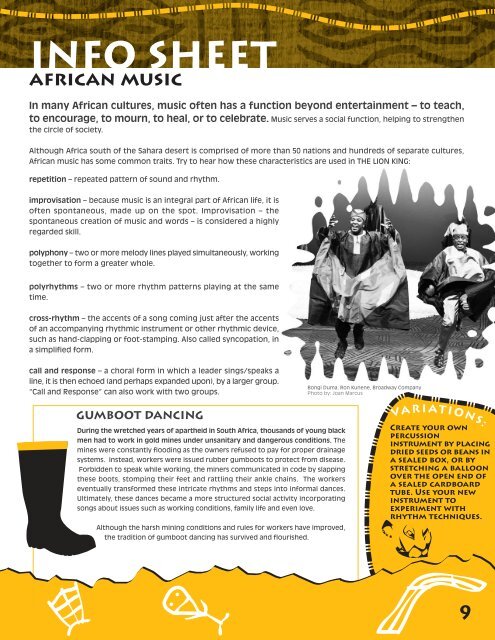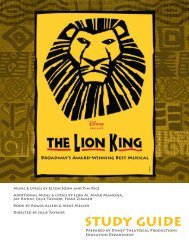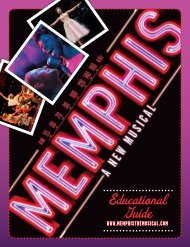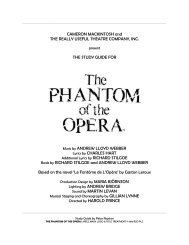The Lion King Study Guide - Telecharge
The Lion King Study Guide - Telecharge
The Lion King Study Guide - Telecharge
You also want an ePaper? Increase the reach of your titles
YUMPU automatically turns print PDFs into web optimized ePapers that Google loves.
INFO SHEET<br />
african music<br />
In many African cultures, music often has a function beyond entertainment – to teach,<br />
to encourage, to mourn, to heal, or to celebrate. Music serves a social function, helping to strengthen<br />
the circle of society.<br />
Although Africa south of the Sahara desert is comprised of more than 50 nations and hundreds of separate cultures,<br />
African music has some common traits. Try to hear how these characteristics are used in THE LION KING:<br />
repetition – repeated pattern of sound and rhythm.<br />
improvisation – because music is an integral part of African life, it is<br />
often spontaneous, made up on the spot. Improvisation – the<br />
spontaneous creation of music and words – is considered a highly<br />
regarded skill.<br />
polyphony – two or more melody lines played simultaneously, working<br />
together to form a greater whole.<br />
polyrhythms – two or more rhythm patterns playing at the same<br />
time.<br />
cross-rhythm – the accents of a song coming just after the accents<br />
of an accompanying rhythmic instrument or other rhythmic device,<br />
such as hand-clapping or foot-stamping. Also called syncopation, in<br />
a simplified form.<br />
call and response – a choral form in which a leader sings/speaks a<br />
line, it is then echoed (and perhaps expanded upon), by a larger group.<br />
“Call and Response” can also work with two groups.<br />
GUMBOOT DANCINGVAR I AT I ONS:<br />
During the wretched years of apartheid in South Africa, thousands of young black<br />
men had to work in gold mines under unsanitary and dangerous conditions. <strong>The</strong><br />
mines were constantly flooding as the owners refused to pay for proper drainage<br />
systems. Instead, workers were issued rubber gumboots to protect from disease.<br />
Forbidden to speak while working, the miners communicated in code by slapping<br />
these boots, stomping their feet and rattling their ankle chains. <strong>The</strong> workers<br />
eventually transformed these intricate rhythms and steps into informal dances.<br />
Ultimately, these dances became a more structured social activity incorporating<br />
songs about issues such as working conditions, family life and even love.<br />
Although the harsh mining conditions and rules for workers have improved,<br />
the tradition of gumboot dancing has survived and flourished.<br />
Bongi Duma, Ron Kunene, Broadway Company<br />
Photo by: Joan Marcus<br />
Create your own<br />
percussion<br />
instrument by placing<br />
dried seeds or beans in<br />
a sealed box, or by<br />
stretching a balloon<br />
over the open end of<br />
a sealed cardboard<br />
tube. Use your new<br />
instrument to<br />
experiment with<br />
rhythm techniques.<br />
9





